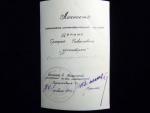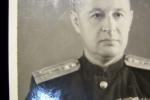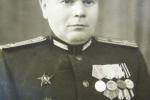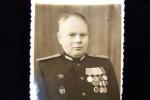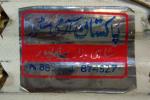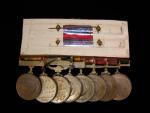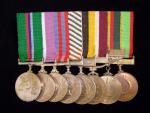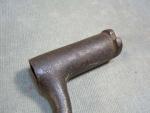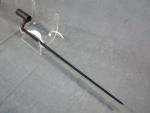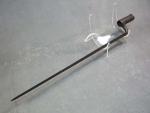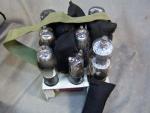-
Posts
6,486 -
Joined
-
Last visited
-
Days Won
10
Content Type
Profiles
Forums
Blogs
Gallery
Events
Store
Everything posted by Brian Wolfe
-

Soviet Help with rank and translation please
Brian Wolfe replied to Brian Wolfe's topic in USSR: Soviet: Other Militaria
This is the lower 1/2. Sorry it takes so long for me to post these photo, it's not the tools, it's the user who is slow. -

Soviet Help with rank and translation please
Brian Wolfe replied to Brian Wolfe's topic in USSR: Soviet: Other Militaria
-

Soviet Help with rank and translation please
Brian Wolfe replied to Brian Wolfe's topic in USSR: Soviet: Other Militaria
-

Soviet Help with rank and translation please
Brian Wolfe replied to Brian Wolfe's topic in USSR: Soviet: Other Militaria
This is a closer view of the shoulder boards. I can't make out the device next to the shoulder board's button, it's round and looks like a star on this round disk. I'll post the views of the back next. Brian -

Soviet Help with rank and translation please
Brian Wolfe replied to Brian Wolfe's topic in USSR: Soviet: Other Militaria
This is the second photo that I need help with, the third one has nothing written on the back just a stamp but this one seems to have quite a bit. There are two dates on the back, 10.5.1951 and 24 (month?) 1956. The medals are hard to make out but it would look like two Combat Service Medals (is that possible), I don't know the middle one, and the last two look like the victory over Germany and victory over Japan. He does have the Order of the Red Star as well. Thanks again in advance for your help. Regards Brian -

Soviet Help with rank and translation please
Brian Wolfe replied to Brian Wolfe's topic in USSR: Soviet: Other Militaria
Thank you Rick, you are amazing. Regards Brian -

Soviet Help with rank and translation please
Brian Wolfe replied to Brian Wolfe's topic in USSR: Soviet: Other Militaria
This is what is written on the back of the photo. Any help with the translation and the meaning of the stamp would be very welcomed. Many thanks Brian -

Soviet Help with rank and translation please
Brian Wolfe replied to Brian Wolfe's topic in USSR: Soviet: Other Militaria
-

Soviet Help with rank and translation please
Brian Wolfe posted a topic in USSR: Soviet: Other Militaria
Hello Everyone, I have been trying to add photos of medals in wear that I have in my collection. With that in mind I purchased 3 photos of Soviet Officers but I am not versed in this area and would like help with the rank, date of photo as well as the translation of the writing on the back of the photo. I think these are official photos of some sort due to the stamp. Any help would be greatly appresiated. Regards Brian The first photo (I'll post each one as I have time) I think is of a Lieutenant Colonel going by his shoulder boards and the collar boards which I believe indicate a senior command personnel. This is a new area for me so I am probably way off on the rank. I see he is wearing a badge "To the Guards" as well as the Order of the Red Star. I have not identified the medals yet. Would the badge indicate he is an officer in the Border Guards? -
Hi Ed, I've been grounded from cyber space for the past three days after my computer crashed. Your posts were a welcomed treat upon my return. Thanks for showing these great medals. Regards Brian
-
Thanks for the translation, Ed. Regards Brian
-
Oops that was a typo, it should have read Resolution not Revolution. By the way the medal was issued in 1988, from my sources. Brian
-
The tailor's label is show in closeup. Can anyone provide a translation of the label? Thanks for looking and any help with the translation would be much appresciated. Regards Brian
-
Here is the back of the mount. As you can see this has the "look" of being an authentic group. One of the two pins is missing but it still has the tailor's label in place. Brian
-
Hello Everyone, Considering the number of faked groups of Pakistan medals that are on the market I usually stear clear of them. This group, however, had the "look" of being halal so I've added it to the collection. These are all unnamed which is normal when talking about the medals of Pakistan. This group consists of, Tamgha-i-Jang 1971/War Medal 10 Year Military Service Medal 20 Year Military Service Medal Wiladat-i-Quaid-i-Azam Medal (1976) Hiri Medal (1979) Jamhuriat Medal 1988 Pakistan Resolution Golden Jubilee 1988 Independence Day Golden Jubilee Medal (1997) Looking at the medals and the dates they were issued (in brackets) it would look like this soldier served from at least 1971 until 1997. Considering he would have been in the military after 1997 in order to have actually received the Independence Golden Jubilee Medal we are looking at a career of around 26 or 27 years as there is no 30 Year Military Service Medal in the group. It would also seem to indicate, according to the medals in the group, that he served during the 1971 Indo-Pakistan War but did not see combat. I hope you like my latest addition. Regards Brian
-
From what I have read the non-regulation bades that were worn were ancestral (family) blades. The sword in question had a machine-made blade as did almost all of the "regulation" swords of WWII. I'm not sure but I don't believe the military would have allowed this pattern to be worn unless it was an issued item. Ancestral blades would have been made before 1877. That's not to say there were no hand-made blades carried during WW II that were made later than 1877, but these were always with the regulation hilts, either army or navy. I have one such blade that was hand-made in the 1930's but again this was carried with the regulation hilt. Regards Brian
-
While going through some of the older posts I noticed that the Senior Sergeant in this photo is holding the pattern c. 1886 Cavalry Trooper's Sword mostly associated with the Russo-Japanese War (1904 - 05), see post #21 for the photo. Since he is wearing the Manchurian Incident War Medal, it places him well after the Russo-Japanese War and it would seem to support one theory I've read that these cavalry swords continued in use well into WW II. I have two distinct patterns of this sword in my collection, one is basically a shorter version of the more common sword. This was NOT a cut down from a damaged sword but a shorter pattern. Has anyone else encountered a short version of the c. 1886 Cavalry Trooper's Sword? Thanks for posting this photo Paul. Regards Brian
-

Infanteriegewehr M1809 Bayonet - Prussia
Brian Wolfe replied to Brian Wolfe's topic in Swords & Edged Weapons
This is the view of the only marking ("48") to be found on this bayonet. It's a good thing there are other indicators when idnetifying such items. Regards Brian -

Infanteriegewehr M1809 Bayonet - Prussia
Brian Wolfe replied to Brian Wolfe's topic in Swords & Edged Weapons
-

Infanteriegewehr M1809 Bayonet - Prussia
Brian Wolfe replied to Brian Wolfe's topic in Swords & Edged Weapons
This is the view of the hook that is cut out of the locking collar. Brian -

Infanteriegewehr M1809 Bayonet - Prussia
Brian Wolfe replied to Brian Wolfe's topic in Swords & Edged Weapons
-
Hello Everyone, A friend of mine purchased a small warehouse in Kitchener, Ontario, Canada a few months ago and found some interesting items left by former owners. One of the items was this bayonet that he gave me. It is Prussian and is for the Infanterie-gewehr M1809 (the "Neupreussisches Gewehr"). The dimensions are as follows: Overall length: 568 mm Socket length: 78 mm Blade length: 490 mm Shank Length: 31 mm While I can find no markings on the blade due to condition there would have been found a letter, such as "B" on the top of the blade with I, R and K under each other on the underside of the blade. The right side of the shank is marked, in this case, with the number "48". The original condition would be "polished bright" all over. What helped me in identifing this bayonet, along wth the diamensions is the fact that the socket has no cut out or locking ring but is secured using only a hook that is cut out of the rear re-inforcement collar. This is a rather distinctive feature of these bayonets. The socket of this baynoet is simalar to the Prussian M1839 though the blades differ. It makes one wonder how a Prussian bayonet ended up in a warehouse in Kitcheren Ontario. Kitchener was called Berlin until 1916 when due to pressure from the public (WW I) the city was re-named "Kitchener". Still the settlers coming from Germany and/or Prussia during the early years of settlement were generally farmers and not military men. Perhaps the location of the bayonet has no connection what-so-ever to the past early pioneers. We'll never know. Research for this post was taken from:Bayonets of the World by Paul Kiesling, Volume Two, Pg. 31, Entry Number 335, Published by Military Collectors Service - Holland. Regards Brian
-
This is the view of the three valves located underneath the rack as indicated on the fabric diagram noted in the second photo of this series. Now for one more part and I can display the radio as I have been planning. I was offered a half track truck to mount this radio in but I declined as that would be pushing the whole collecting thing too far for my budget and available space. Tempting though.... Regards and stay tuned for more on this project. Brian
-
In this photo you can see the valves on the removed rack with one of the protective socks removed. Quite often these protectors as well as the fabric diagram as missing in these sets that are being offered to collectors. I'm happy to have gotten a complete one. The fabric strap for removing and returning the valves from and to the container can also be seen in this photo. Regards Brian





